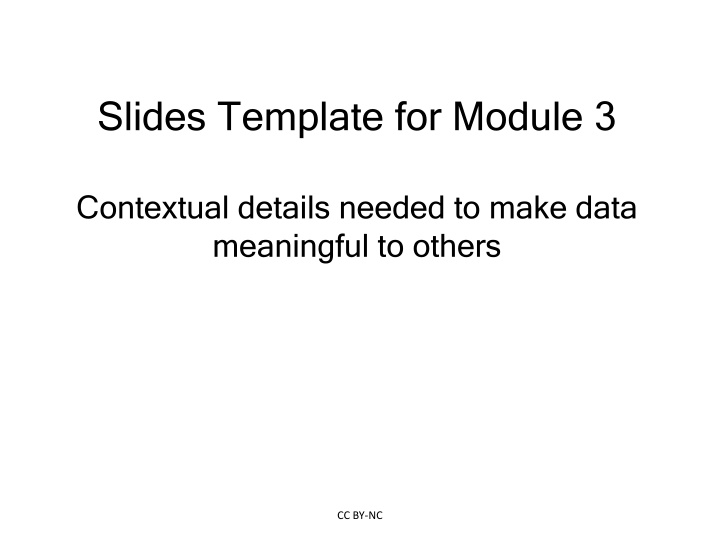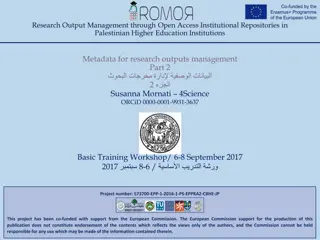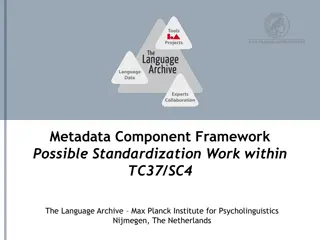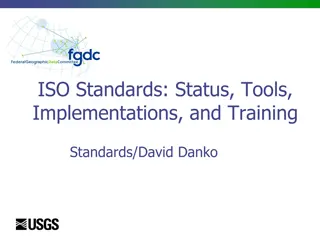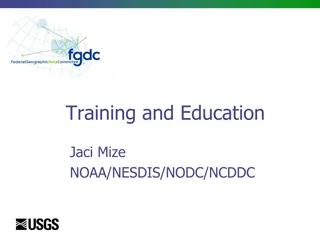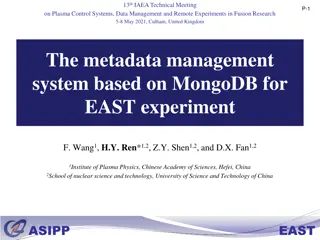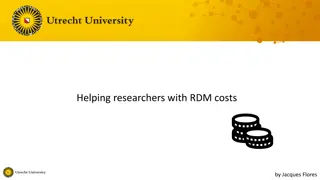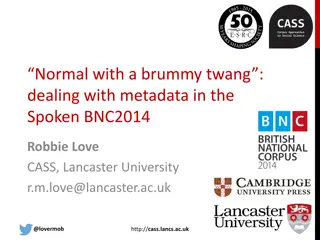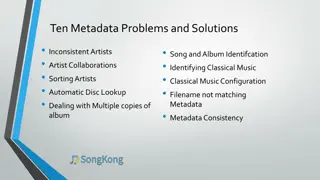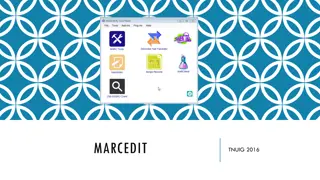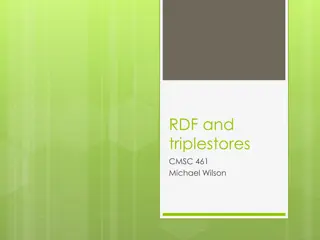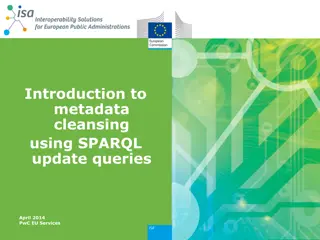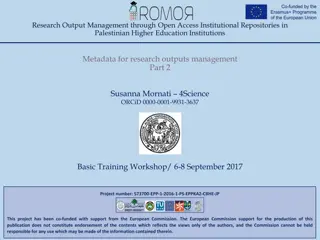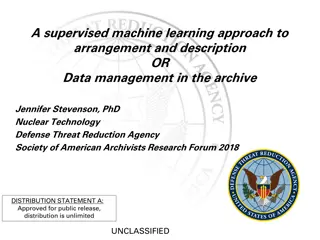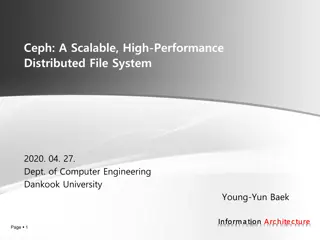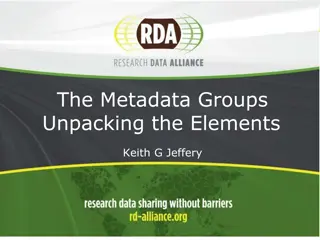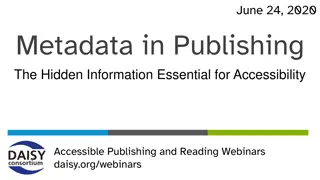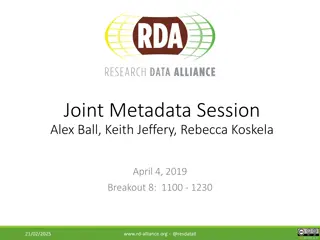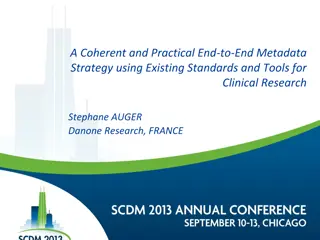Essential Metadata Principles for Data Management
Metadata, crucial for data retrieval and reuse, is structured information that simplifies information resource management. It details the What, Why, and How of metadata, emphasizing its vital role in research, data utilization, and long-term data preservation. Learn about the types of metadata, standards like Darwin Core and EML, controlled vocabularies, and more to enhance discoverability and ensure efficient data sharing.
Download Presentation

Please find below an Image/Link to download the presentation.
The content on the website is provided AS IS for your information and personal use only. It may not be sold, licensed, or shared on other websites without obtaining consent from the author.If you encounter any issues during the download, it is possible that the publisher has removed the file from their server.
You are allowed to download the files provided on this website for personal or commercial use, subject to the condition that they are used lawfully. All files are the property of their respective owners.
The content on the website is provided AS IS for your information and personal use only. It may not be sold, licensed, or shared on other websites without obtaining consent from the author.
E N D
Presentation Transcript
Slides Template for Module 3 Contextual details needed to make data meaningful to others CC BY-NC
Learning Objectives 1. Understand what metadata is 2. Understand why metadata is important 3. Identify applicable standards for capturing and documenting metadata 4. Understand disciplinary practices associated with the collection and documentation of metadata 5. Identify an approach to creating metadata for a project Module 3: Metadata
What is Metadata? Metadata is structured information that describes, explains, locates, or otherwise makes it easier to retrieve, use, or manage an information resource. Metadata is often called data about data or information about information (NISO, Understanding Metadata 2004;1). Module 3: Metadata
You Must Have Metadata to: find data from other researchers to support your research; use the data that you do find; help other professionals to find and use data from your research; and use your own data in the future when you may have forgotten details of the research. Module 3: Metadata
Basic Types of Metadata Descriptive metadata Descriptive metadata Structural Structural metadata metadata Administrative metadata Administrative metadata Module 3: Metadata
How Metadata Facilitates Discoverability and Reuse Discoverability Accessibility Module 3: Metadata
Some Sample Metadata Standards Darwin Core Ecological Metadata Language (EML) Climate and Forecast (CF) Module 3: Metadata
Collecting and Sharing Metadata Controlled vocabularies Controlled vocabularies Technical standards Technical standards Module 3: Metadata
Controlled Vocabularies Help take the guess work out of choosing between: a preferred spelling; a scientific or popular term determining which synonym to use. Module 3: Metadata
Technical Standards ISO 8601 technical standard: YYYY (e.g. 1997) Year and month: YYYY-MM (e.g. 1997-07) Complete date: YYYY-MM-DD (e.g. 1997-07-16) Media types can be problematic as well The MIME media types helps you choose among the following: Application, audio, example, image, message, model, multipart, text, video Module 3: Metadata
Media Types The MIME media types: Application Audio Image Model Multipart Message Text Video Module 3: Metadata
Approaches to Creating Metadata First, identify your elements: Title Creator Identifier Subject Dates Module 3: Metadata
Best Practices Consult a metadata librarian! Consistent data entry is important Avoid extraneous punctuation Avoid most abbreviations Use templates and macros when possible Extract pre-existing metadata Keep a data dictionary Always use an established metadata standard Module 3: Metadata
Sources for this Unit What is metadata: What is metadata: National Information Standards Organization (NISO). 2004. Understanding Metadata. http://www.niso.org/publications/press/UnderstandingMetadata.pdf Neiswender, C. 2010. "Introduction to Metadata." In The MMI Guides: Navigating the World of Marine Metadata. http://marinemetadata.org/guides/mdataintro. Accessed April 1, 2013. Reuse and discoverability: Reuse and discoverability: National Information Standards Organization (NISO). 2004. Understanding Metadata. http://www.niso.org/publications/press/UnderstandingMetadata.pdf Miller, Steven J. 2011. Metadata Resources: Selected Reference Documents, Web Sites, and Readings: https://pantherfile.uwm.edu/mll/www/resource.html Wikipedia page on Metadata : http://en.wikipedia.org/wiki/Metadata http://www.library.illinois.edu/dcc/bestpractices/chapter_11_structuralmetadata.html Module 3: Metadata
Sources for this Unit (contd) Metadata Metadata standards: standards: Digital Curation Centre s Disciplinary Metadata resource. http://www.dcc.ac.uk/resources/metadata- standards. Hogrefe, K., Stocks, K. 2011. "The Importance of Metadata Standards." In The MMI Guides: Navigating the World of Marine Metadata. http://marinemetadata.org/guides/mdatastandards/stdimportance. Accessed March 22, 2013. Other suggested readings Other suggested readings Introduction to Metadata: Setting the Stage (Getty Research Institute) http://www.getty.edu/research/publications/electronic_publications/intrometadata/setting.html Documentation and Metadata (MIT Libraries): http://libraries.mit.edu/guides/subjects/data- management/metadata.html Version control and authenticity http://data-archive.ac.uk/create-manage/format/versions Module 3: Metadata
Other Suggested Readings (contd) What is Metadata? http://vimeo.com/3161893 Controlled vocabularies and technical standards http://en.wikipedia.org/wiki/Controlled_vocabulary http://www.ieee.org/education_careers/education/standards/standards_glossary.html Metadata elements http://libraries.mit.edu/guides/subjects/data-management/metadata.html Creating metadata http://uwdcc.library.wisc.edu/documents/DC_companionv1.3.pdf Module 3: Metadata
